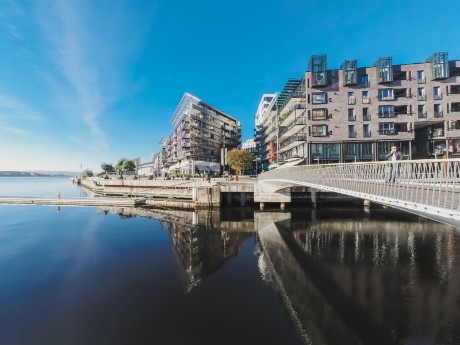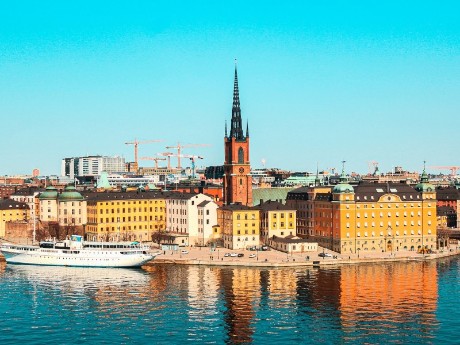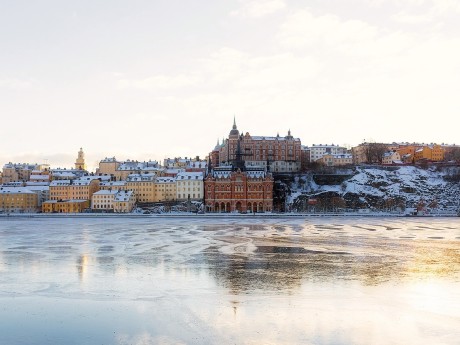Norway and Sweden: Oslo & Stockholm
World-famous Oslo Opera House, ancient Akershus Fortress, grand Royal Palaces, and historic open-air museums. Beginning in the capital of Norway, Oslo, visit the famous Oslo Opera House opened in 2008 which has spectacular designs. Visit Frognerparken, the 45 hectare park with the world's largest sculpture park made by a single artist.
Read more
World-famous Oslo Opera House, ancient Akershus Fortress, grand Royal Palaces, and historic open-air museums. Beginning in the capital of Norway, Oslo, visit the famous Oslo Opera House opened in 2008 which has spectacular designs. Visit Frognerparken, the 45 hectare park with the world's largest sculpture park made by a single artist. Another unmissable attraction is Akershus Fortress, a medieval castle which was used as a prison for deserters and other criminals during the Nazi regime in WW2. The trip continues to Stockholm, the capital of Sweden. Begin with Vasa Museum which is one of the most visited museums in Scandinavia, and it holds the world's only preserved ship (a 64-gun warship) from the 17th century. The Royal Palace is also a must see as it is one of Europe's largest and oldest castles that still serves as an official royal residence (for King Carl XVI Gustaf). To add, check out Skansenthe, the oldest open-air museum and zoo in Sweden showcasing the whole of Sweden with houses and farmsteads from every part of the country. Waterviews strives to offer accommodation options within walking distance of water and/or in an area of touristic interest. Our prices include taxes (but excludes local tourist taxes). Customize your trip to your personal preferences with optional activities (hit the “Add Activities’’) or change hotels, etc. Contact us for customization at no extra cost at: Service@waterviewstravel.com
Destinations
- Oslo
- Stockholm
Itinerary
Oslo

Norway’s modern and cosmopolitan capital is surrounded by sea and mountains and boasts itself as one of the most sustainable and green cities in the world. The city is also home to a vibrant and contemporary cultural scene, with great food, fun nightlife and numerous attractions such as museums and art galleries. With its innovative architecture, surrounding nature and excellent attractions, the city of Oslo is just waiting to be explored.
Read more
Norway’s modern and cosmopolitan capital is surrounded by sea and mountains and boasts itself as one of the most sustainable and green cities in the world. The city is also home to a vibrant and contemporary cultural scene, with great food, fun nightlife and numerous attractions such as museums and art galleries. With its innovative architecture, surrounding nature and excellent attractions, the city of Oslo is just waiting to be explored.
Additional Information
Oslo is the demographic, economic and political centre of Norway. As the capital of Norway, Oslo hosts several national institutions. The city has a good selection of cultural institutions and a good selection of restaurants, some world class but most ordinary, as well as night life in general. While it is an expensive city for overseas visitors, many of the best things are free of charge, notably Oslo's proximity to wild nature and variety of outdoor activities.
Metropolitan Oslo also includes most of Akershus county and the line between these is so blurred that the two is seen as one city. Local public transport such as the Oslo metro covers Oslo proper and the surrounding districts. Oslo proper has well over 600,000 inhabitants while metropolitan Oslo has around 1 million inhabitants. Oslo's influence is felt well beyond the metropolitan area and the wider "Oslo region" includes the densely populated lowlands around the inner Oslo fjord and the flatlands around the airport. This region covers only 5% of Norway's area but has 25 to 30% of the population.
Name and history
The history of the city can be traced back over one thousand years. Oslo was founded in 1048, by the king Harald Hardråde. The city became the capital of Norway around 1300, but lost its privileges during the Danish-Norwegian union from 1348 to 1814. In 1624, a fire devastated old Oslo, and the city was moved some kilometres west to gain protection from the fortress at Akershus. The new city was built in a strict grid plan that still appears modern, this area is now within downtown Oslo (between Akershus fortress and Oslo cathedral) and known as Kvadraturen.
The city was renamed Christiania, after the Danish King Christian IV, a name that remained until it was officially renamed on 1 January 1925 to Oslo. Traces have been found close to Ekeberg indicating settlement as far back as 10,000 BC. After the 1624 fire Oslo/Christiania was built exclusively from brick and stone; this gives a city clearly different appearance compared with wooden towns like Bergen, Stavanger and Trondheim.
After the devastating 1624 fire, old Oslo (around the mouth of river Aker) was largely abandoned and the ruins converted to farmland. Today, a few church ruins are still visible under the Ekeberg hill (across the water from the new opera house, between road E18 and the railway). Beyond these ruins virtually nothing remains of medieval Oslo. The new city Christiania was established outside the borders of Oslo, and 'Oslo' remained the name of the small, surviving settlement outside the new city borders. During Christiania's rapid expansion in the 19th century, as the capital of a new state, the site of original Oslo (old Oslo, or 'Gamlebyen') was included in the city. Due to the rapid inclusion of surrounding agricultural areas in the 19th century, many remnants of the city's farming history are still clearly visible in place names and farmhouses. The remains of historical pastures can be found at parks such as St. Hanshaugen.
In 1814 Christiania became the capital of the new state under the Swedish crown. The city was still a small town with a few thousand inhabitants, notably smaller than Bergen. During the 1800s Oslo expanded rapidly to become a big city. In 1850 there were some 30,000 people living in the city, by 1900 this had grown ten-fold, and by 1950 Oslo had more than 500,000 inhabitants. The rapid expansion in the late 1800s was particularly related to the heavy industry around Akerselva (river) - the river and waterfalls provided water and power to the factories, ship building along fjord notably what is today Aker brygge was also important. Today most heavy industry has left the city.
Modern competitive skiing was developed in Oslo. Ski jumping, cross-country skiing and downhill/slalom races have been held in Oslo since 1866. Downhill/slalom were further developed in the Alp region and then got the name "alpine skiing". This strong tradition is visible in the imposing Holmenkollbakken (a ski jumping venue) and a fine network of cross-country tracks throughout the Oslo forest, as well as the skiing museum.
While Oslo has been a safe city in modern times, the government district was hit by a terrorist bomb blast in 2011, killing four people. The damaged buildings have not been replaced (as of 2018).
Geography
Oslo, with its approximately 453 km², is one of the largest capitals in the world by area, but most of it is forest, making Oslo a city in close contact with the nature surrounding it. The Oslo fjord extends northwards from the Skagerrak sea. Oslo has an impressive archipelago of islands, which in summer becomes the city's favoured playground.
Oslo is situated in an amphitheatre-like setting, with the city centre in the bottom close to the Oslo fjord, and residential areas stretching uphill from there in all directions. Behind the residential areas, the forested area of Marka (Nordmarka, Østmarka, Lillomarka) extends, with flora and fauna that is quite extraordinary for a city of this size. Moose are commonplace (easily spotted in winter), and the whole of the capital is part of Norway's wolf reserve (even if they rarely come here).
The city centre is bounded by Oslo Central Station (Oslo S) to the east, the Royal Palace (Slottet) to the west and the seafront (from Akershus fortress to Aker brygge) to the south. It's fairly compact and easily walkable. Karl Johans gate, the mostly pedestrian main street connecting Oslo S and the Palace, is the main artery of downtown Oslo. However, several of the neighbourhoods close to the centre hold interesting sights and entertainment offerings, so to explore these you should make use of the city's comprehensive public transport system.
European Green Capital 2019
The city of Oslo has been recognized as the European Green Capital for 2019. This means that the city is in a process of achieving the global goals for a better climate and to minimize the air pollution and the water pollution within the city. There is also a strong focus on reuse to reduce litter. Maximum environmental friendly transport is also one of the ambitions. Read more about the environmental initiative here.
Climate
Although well into the northern latitudes, Oslo's climate is fairly temperate thanks to warm air being wafted across the Atlantic from the Gulf Stream. Summer weather in Oslo is mild and pleasant, with frequent hot spells, and plenty of long sunny days. In winter temperatures hover just above or below freezing. Snow is most often plentiful in the forested areas and also often in the city in winter, making it a great winter sports venue. Rainfall is spread across the year, the rainiest month being August.
People
Oslo proper has a population of 647,000 people, or 900,000 when including its extra-municipal suburbs (such as Bærum and Lørenskog). The Oslo metropolitan area has a population of around 1.4 million. The diverse population includes some of Norway's wealthiest celebrities and socialites, as well as more than 150,000 immigrants. This has made Oslo a highly ethnically and culturally diverse city, with 28% of the city's population having an immigrant background. Accompanied by a large influx of people from all around Norway, Oslo is thus often referred to as the "melting pot" of Norway. Cultural differences have affected Oslo's society and cityscape in matters of food, shopping, crime and so on, which have all blended in to the everyday life of Oslo's population. Some areas of Oslo, especially around Grønland and Tøyen, and many suburbs east of the city centre, have majority-immigrant or majority non-ethnic Norwegian populations. Depending on the area, the most notable immigrant communities are Pakistani, Somali, Swedish, Sri Lankan, Iraqi, Polish, Vietnamese, Iranian, ex-Yugoslavian, Moroccan, Turkish, Albanian, Filipino, Thai and Danish. Pakistani immigrants and their descendants form the largest minority group in Oslo.
Economy
The Oslo region is the country's premier business centre and has a diverse and dynamic economy with one of the highest regional GDPs in Europe. Figures published by the regional development agency for Oslo show that GDP per capita in the region was €44,190 (excluding oil and gas) in 2000, compared to an EU average of approximately €20,000. According to a report produced by the city's Chief Commissioner's Department and the Department of Finances and Development, the service sector dominates employment in Oslo. In 2001, Public and Business services accounted for more than 59 percent of jobs. Other major employment areas within the service sector include trade, hotels and catering, banking and insurance.
Orientation
Following the latest reform of January 1, 2004, the city is divided into 15 boroughs (bydeler). Most tourist attractions are concentrated in the city centre (Sentrum). Some other districts of note are Frogner, a hilly residential district with the namesake park famous for the Vigeland sculptures, and the Grünerløkka, hub for nightlife and the creative scene, while Munch museum is at Tøyen in the inner eastern suburb.
Traditionally, Oslo has been divided into the eastern and western parts, with the West being the more affluent, with elegant buildings and a posh character, and the East consisting of working-class neighbourhoods, growing into a home for both the artistic bohemian and poor immigrant communities.
For the short term visitor, navigation is typically related to key buildings and streets in the Central downtown area. Karl Johans gate (known merely as Karl Johan) is Oslo's main street and runs from the railway station passed and towards the Royal Palace. Key buildings are concentrated around this street, notably the University, the Nationaltheateret, the Cathedral and Stortinget (Parliament). In the adjacent streets the City Hall, Nobel peace centre (previous West station), Ministries (government buildings), the Supreme court, and major museums. The nightlife district at Aker brygge is a short stroll from Karl Johan. The new Opera house is next door to the railway station. In addition to the Central railway station, next door to the Nationaltheateret and Palace there is the second main station underground served by airport trains, local trains and all metro lines.
© Sourced from Wikivoyage
Stockholm

As well as being the cultural, economic and political heart of Sweden, Stockholm enjoys a picturesque location stretching over fourteen islands where Lake Mälaren meets the Baltic Sea. Gamla Stan is filled with colourful buildings, cobblestone streets lined with trendy cafes and restaurants and historical buildings such as the Storkyrkan Cathedral. Stockholm has something for everyone, with Scandinavian design, world-class museums detailing everything from the Vikings to Abba, and a centre filled with green parks and scenic waterfronts.
Read more
As well as being the cultural, economic and political heart of Sweden, Stockholm enjoys a picturesque location stretching over fourteen islands where Lake Mälaren meets the Baltic Sea. Gamla Stan is filled with colourful buildings, cobblestone streets lined with trendy cafes and restaurants and historical buildings such as the Storkyrkan Cathedral. Stockholm has something for everyone, with Scandinavian design, world-class museums detailing everything from the Vikings to Abba, and a centre filled with green parks and scenic waterfronts.
Additional Information
Due to post-glacial rebound, much of today's Stockholm used to be under water. Mälaren was a bay of the Baltic Sea throughout the Viking Age of the 9th and 10th centuries; today's Stockholm was the waterway for the first Swedish cities; Birka, Uppsala, and Sigtuna. As Sigtuna was sacked by pirates in AD 1187, the Swedes needed to fortify the strait.
As the rising land cut off Mälaren from the sea in the 13th century, Stockholm became an important trading post. The city is said to be founded by Birger jarl (jarl is a title corresponding to British earl), who had a fortress built on an island later known as Gamla Stan. The first known written records that mention Stockholm date from 1252; this is the considered year of foundation. In the 15th century Stockholm replaced Uppsala as the effective capital. Stockholm was an associate of the Hanseatic League, and since its liberation from Denmark by King Gustavus Vasa in 1523, Stockholm has remained Sweden's most important center of commerce, although Gothenburg later became the largest international port. During the 17th century, Stockholm was the base of the Swedish Empire, with a land area twice the country's current size, nearly encircling the Baltic Sea.
Much of the inner city plan was laid out in the 19th century, and the inner city still contains buildings from all ages since the 15th century. Like the rest of Sweden, Stockholm was largely untouched by the World Wars, but, particularly between 1955 and 1975, hundreds of old buildings in Norrmalm were demolished in a large-scale modernization process, emulating similar projects in other European cities.
Since 1901, Stockholm has hosted the annual Nobel Prize ceremony for all categories except the peace prize, which is handed out in Oslo. In the 20th century, metropolitan Stockholm sprawled out across most of Stockholm County, with the development of the Stockholm Metro, famous for its contemporary art. 1950s suburbs such as Vällingby became a model for suburban development in other cities. While most of the attractions are in the inner city, a majority of the citizens live in the suburbs.
Otherwise a safe and calm city, Stockholm is also known for the term Stockholm Syndrome, which was coined to describe a hostage's sympathy for a captor during a bank robbery in Norrmalm in 1973.
Sustainable technology
As of the 21st century, Stockholm struggles to become a world leading city in sustainable engineering, including waste management, clean air and water, carbon-free public transportation, and energy efficiency. Lake water is safe for bathing, and in practice for drinking (though not recommended).
Some new neighborhoods with state-of-the-art technology in this field are Hammarby Sjöstad, Norra Djurgårdsstaden and Hagastaden.
Climate
Despite its northern location, Stockholm has fairly mild temperatures throughout the year. The city sees a dramatic seasonal variation in sunlight, from more than 18 hours of daylight around Midsummer, to around 6 hours of daylight around Christmas. Stockholm has an average of nearly 2,000 hours of sunshine a year. Average yearly precipitation is 539 mm (21.2"), with July and August slightly the wettest months. Snowfall can occur from late November to early April, but the amount of snowfall and snow on the ground varies greatly from year to year, and through the winter. No date is a safe bet for snow in Stockholm; for real Scandinavian winter, visit Dalarna or Norrland.
In other words, May to September tend to have the most comfortable weather. From Midsummer to the end of July, most inhabitants leave the city, and some venues close for summer, making the city more dominated by tourists.
Tourist information
© Sourced from Wikivoyage





